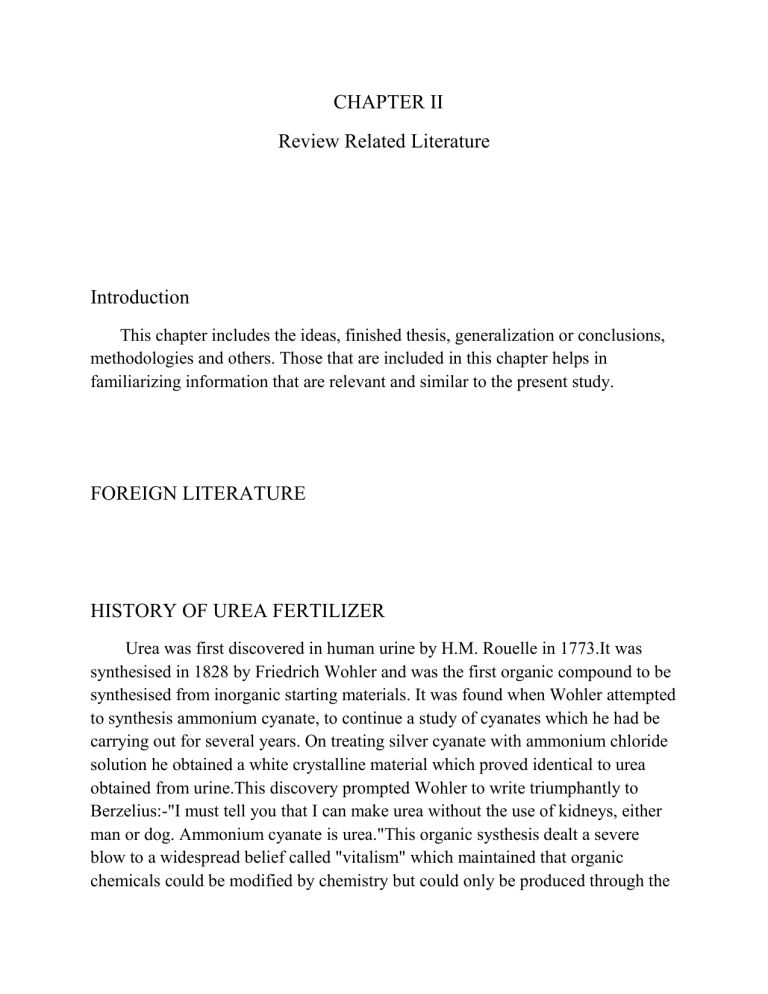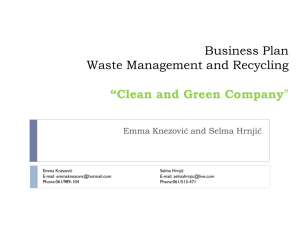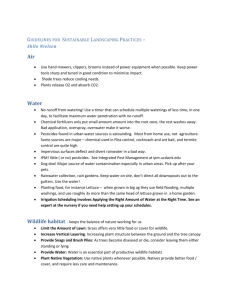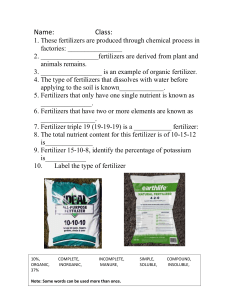
CHAPTER II Review Related Literature Introduction This chapter includes the ideas, finished thesis, generalization or conclusions, methodologies and others. Those that are included in this chapter helps in familiarizing information that are relevant and similar to the present study. FOREIGN LITERATURE HISTORY OF UREA FERTILIZER Urea was first discovered in human urine by H.M. Rouelle in 1773.It was synthesised in 1828 by Friedrich Wohler and was the first organic compound to be synthesised from inorganic starting materials. It was found when Wohler attempted to synthesis ammonium cyanate, to continue a study of cyanates which he had be carrying out for several years. On treating silver cyanate with ammonium chloride solution he obtained a white crystalline material which proved identical to urea obtained from urine.This discovery prompted Wohler to write triumphantly to Berzelius:-"I must tell you that I can make urea without the use of kidneys, either man or dog. Ammonium cyanate is urea."This organic systhesis dealt a severe blow to a widespread belief called "vitalism" which maintained that organic chemicals could be modified by chemistry but could only be produced through the agency of a vital force present in living plants and animals.In 1870 urea was produced by heating ammonium carbamate in a sealed vessel. This provided the basis of the current industrial process for its production. Agricultural Urea is used as a nitrogen release fertilizer as it hydrolyses back to 2NH2 and CO2 but its most common impurity (biuret,NH2-CO-NH-CO-NH2) must be present at less than 2% as it impairs plant growth. It is also used in many multicomponent solid fertilizer formulations. Its action of nitrogen release is due to the conditions favouring the reagent side of the equilibriums which produce urea. Industrial Uses Urea has the ability to form 'loose compounds' with many organic compounds. The organic compounds are held in channels formed by interpenetrating helices comprising of hydrogen bonded urea molecules. This behaviour can be used to separate mixtures and has been used in the production of aviation fuel and lubricating oils. As the helices are interconnected all helices in a crystal must have the same 'handedness'. This is determined when the crystal is nucleated and can thus be forced by seeding. This property has been used to separate racemic mixtures. THE HISTORY OF COMPOST The expression "older than dirt" certainly applies to compost. Nature has been producing compost for millions of years as part of the cycle of life and death on Earth. The first human use of animal manure, a raw form of compost, was in about 3,000 B.C. in Egypt when it was spread directly on the fields as a fertilizer. Later, manure was mixed with dirty stable straw and other refuse and allowed to sit in piles until it was needed. Rain kept the piles wet and aided the decomposition process, producing a rich compost. The Greeks and Romans knew the value of compost to boost crop production and even used the warmth of decomposing compost to produce summer vegetables in winter. Christian monasteries kept the art of composting alive in Europe after the fall of the Roman Empire, and by about 1200 compost was again being used by many farmers. Shakespeare mentions it in several of his plays written in the early 1600s. In the United States, Presidents George Washington and Thomas Jefferson were prominent landowners during the late-1700s and early-1800s. When they were not involved with affairs of state, they both spent much of their time trying innovative farming practices, including experiments with various composting methods and materials. As years of successive crops depleted the nutrients in the soil on the East Coast, the practice of composting became widespread. This trend continued until the early 1900s when it was estimated that 90% of the fertilizer used in the United States came from compost. That all changed in 1913, when a German company began producing synthetic nitrogen compounds, including fertilizers. These new chemical fertilizers could be produced less expensively than messy animal manure compost, and the farmyard compost pile quickly became a thing of the past. By 1950, it was estimated that only 1% of the fertilizer used in the United States was derived from compost. One notable exception to this trend was the work started in 1942 by J.I. Rodale, a noted pioneer in the development of the organic method of farming. Rodale was one of the first to see the hazards of relying on synthetic fertilizers and the benefits of using compost derived from natural sources. Composting got a short-lived boost during the environmentally conscious era of the 1960s, but it wasn't until the 1980s when it became a big business. This surge wasn't the result of a renewed awareness of the positive aspects of compost, but rather a growing concern over the negative aspects of refuse. In short, in our efforts to get rid of our refuse, we werepolluting our air, poisoning our rivers, and quite literally burying ourselves in it with our landfills. In order to divert some of the municipal refuse away from landfills, several cities established recycling centers in the early 1970s where people could bring cans, bottles, and newspaper rather than throw them in the trash. This was followed by curbside recycling, where people could place these recyclable materials in separate containers for pickup in front of their houses. Finally, many citiesadded additional curbside containers for yard wastes to be composted. By 1992, almost 1,500 cities had yard waste composting facilities. At the same time, tough new environmental laws mandated that industries could no longer simply dump their waste products onto the surrounding land or discharge them into nearby rivers. To meet these laws, many industries began their own recycling and composting programs. Environmental concerns also affected farmers, who were being blamed for the negative health effects that chemical fertilizers and pesticides had on humans and wildlife. As a result, many farmers decided to cut back or eliminate chemicals in favor of using compost. Today, most compost is processed in large facilities designed to handle a specific type of raw material. Agricultural compost is usually produced and used on the same farm that generated the raw materials. Industrial compost may be bagged and sold to individual buyers, or the raw materials may be sold in bulk to other composting facilities. Municipal yard waste compost is usually produced in facilities operated by the city or the refuse collection company and is sold to local landscaping companies and garden centers. Impact of Organic and Inorganic Fertilizers on yield, taste, and nutritional quality of Tomatoes. In a greenhouse experiment, tomato plants were grown in sand culture to test whether different fertilization regimes (mineral or organic fertilizers) at low (500 mg N plant–1 week–1) and high (750 mg N plant–1 week–1) nitrogen levels affected yield, nutritional quality, and taste of the fruits. In the mineral-fertilizer treatments, nitrate- or ammonium-dominated nutrient solutions were used. Organic fertilizer was supplied as fresh cut grass-clover mulch (a total of 2.4 kg and 3.6 kg were given per plant at low and high N level, respectively) without (orgN) and with additional sulfur fertilization (orgN+S). Yields of red tomatoes from the organically fertilized plants were significantly lower (1.3–1.8 kg plant–1) than yields from plants that received mineral fertilizer (2.2–2.8 kg plant–1). At the final harvest, yields of green tomatoes in the organic treatment with extra sulfur were similar (1.1–1.2 kg plant–1) to the NOequation image-dominated treatments at both nutrient levels and the NHequation image-dominated treatment at high nutrient level. Organic fertilizers released nutrients more slowly than mineral fertilizers, resulting in decreased S and P concentrations in the leaves, which limited growth and yield in the orgN treatments. Analysis of tomato fruits and plants as well as taste-test results gave no conclusive answer on the relationship between sugar or acid contents in the fruits, macronutrient content of plant leaves and fruits, and perceived taste. Sugar contents were higher in the fruits given mineral fertilizer, whereas acid contents were higher in the fruits given organic fertilizer. Preference in taste was given to the tomatoes from plants fertilized with the nitrate-dominated nutrient solution and to those given organic fertilizer with extra sulfur. Thus, a reduction in growth, which was expected to lead to a higher concentration of compounds like sugars and acids, did not result in better taste. Overall, it can be concluded that an appropriate nutrient supply is crucial to reach high yields and good taste. LOCAL LITERATURE The Effects of Fertilizer Type and Application Time on Soil Properties, Plant Traits, Yield and Quality of Tomato The intensive agricultural practices using chemical fertilizers have helped in increasing crop yields; however, more and more negative effects on soil quality and environmental pollution have been found in areas where chemical fertilizers were overused and/or used for the long-term. Therefore, organic amendments such as crop residues, animal manures, or compost have been widely recognized as a vital agricultural fertilizer resource to improve the soil health and grain yield in an agroecosystem. Furthermore, organic and bio-organic amendments replace part of the waste utilization. To promote the wide application of this technology, many related subjects, such as the type and dosage of organic amendment, the appropriate ratio mixed with chemical fertilizer, nitrogen application time, and other factors such as mixing of organic amendments with different soil organisms (e.g., phosphate-solubilizing bacteria, native free-living nematodes, and epigeic earthworms) have been studied for various crops and vegetables in many countries and regions. However, fewer previous studies have detected two or more factors simultaneously, and the interactions between factors have been mostly ignored . Furthermore, a comprehensive evaluation from soil to plant, that is, including soil properties, plant morphological and physiological traits, yield, and quality, is insufficient at present. Detecting the effects and comprehensive evaluations of multiple factors are of great significance for production practice, and more detailed work should be explored to improve the development of sustainable agriculture. Cow manure, one of the common organic amendments, is rich in minerals and is often used in conventional agriculture. However, organic amendments alone may not offer sufficient nutrient supply to meet the demand for agriculture production. Integrated soil fertility management (ISFM), a technique that makes use of both organic and chemical fertilizer resources, is thus proposed for greater yield response and better nutrient storage. For example, the production of tomato and other vegetables was found to be higher when the one-third chemical fertilizer was applied in combination with two-thirds vermicompost. Because the utilization of nutrients by the plants to an adequate level largely depends upon the nitrogen quantity and time of its application, there is a need to balance the nitrogen application in terms of ratio and time of application [13]. The optimal mixed ratios of organic and chemical fertilizers based on nitrogen have been suggested for crops, vegetables, and fruits.However, applying nitrogen (especially the chemical form), according to the requirements of plants at different growth stages, needs to be taken into more consideration. Tomato (Solanum lycopersicum L.) is one of the most important vegetable crops, with an extensive worldwide distribution and a massive economic value. Its global annual production is currently around 130 million tons. The yield and quality of tomato are largely affected by the method of fertilization. Quite a number of studies have focused on the effects of the mixed ratio of organic and chemical fertilizers on the productivity of tomatoes and soil quality. However, studies with nitrogen application time are much fewer for tomatoes. Furthermore, most fertilization studies of tomato have generally only evaluated the effects on plants or soil quality, solely. Some studies have evaluated both the plants and soil quality but with few parameters. Exploring both the effects of mixed fertilizer and application time, as well as conducting a comprehensive evaluation of both soil and plant, is necessary for the technologies of sustainable agriculture practice. According to the recommended fertilization rate for tomatoes, the total effective nutrients (compost and fertilizer) for each fertilizer treatment were the same: 0.12 g N per kg soil, 0.11 g/kg P2O5 per kg soil, and 0.38 K2O per kg soil. All P, K, compost, and 25% urea for the N25 treatment (or 50% for the N50 treatment) were applied as basal fertilizer, and the remaining 75% (or 50%) urea was applied at the flowering stage, 6 cm below the soil surface around the four sides of the root, about 7 to 8 cm away from the root neck to avoid the root damage. All pots were followed by a full factorial design, randomly arranged in the growth chamber, and re-randomized weekly. Plants were watered 2–3 times a week to compensate for evaporation losses. Weeds were controlled by hand every week during the experimental period. It has been widely accepted that organic fertilizers improve soil fertility and quality better than chemical fertilizers and that different types of compost and vermicomposting are essential for environmental sustainability and soil quality restoration. Nutrients supplied by organic fertilizer release slowly compared with chemical fertilizer, resulting in less loss of fertilizer and better preservation of the soil nutrients. The compost amendment also promotes biological N-transformation frequency in soil, which further enhances the soil’s organic and inorganic nutrients. Furthermore, animal manure amendment may not only act as a substitute for chemical fertilizers but also as a conditioner for soil quality. For example, one of the most beneficial effects of compost application in soils is the increase of organic matter content and carbon accumulation. Therefore, modern agricultural experts recommend the use of animal excreta to improve the soil quality of field land which has been damaged by chemical fertilizers. We found that the soil properties, plant traits, and yield of tomato were significantly affected by the fertilizer treatment but not by the N application time or their interactions. No significant changes in fruit qualities were detected in this experiment. The soil properties, plant traits, and yield of tomato with compostmixed fertilizers performed better than the CK treatment, and some parameters in the CF30 treatment were even better than those with pure chemical fertilizer. Our results clearly showed that the cow manure compost could be applied as a potential source of nutrients to promote plant growth, increase tomato , and improve soil fertility in silty loam texture soil. Establishing an optimal mixed ratio of compost and chemical fertilizer is a critical issue for commercial tomato production, and the chemical nitrogen application time is less important, according to our experimental design. The implication of organic fertilizers in improving soil quality might be greater than its impact on plant yield for sustainable agriculture practices. REFERENCES http://www.chm.bris.ac.uk/motm/urea/urea.html http://www.texasorganicsoil.com/blog/2015/8/12/the-history-ofcompost#:~:text=The%20first%20human%20use%20of,piles%20until%20it%20w as%20needed. https://onlinelibrary.wiley.com/doi/abs/10.1002/jpln.200520553#:~:text=Preferenc e%20in%20taste%20was%20given,not%20result%20in%20better%20taste. https://www.mdpi.com/2071-1050/12/21/9065




